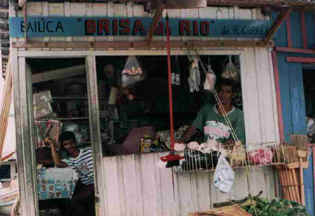 The following story illustrates pertinently the élite view of people in the rural areas around Óbidos, a small town on the Amazon river. Soon after I arrived in Óbidos, I introduced myself to the people who ran the small Museu Integrado de Óbidos, which held a collection of artefacts, some imported from Europe in the nineteenth century and some locally made. I talked with two ladies from rich Óbidense families. Having explained that I had returned from a rural community that morning, they said how lovely the interior is during the dry season. I then explained my research and intentions. This declaration was met coolly, with the comment that 'there is no need to help os caboclos, because nature helps them'. She continued, 'Look here, the laziness of the caboclo of the region is a result of nature helping them too much and being too kind to them, fish and birds are free. And because nature helps them, they don't need to work'. I heard variations of this view throughout fieldwork; the interesting point is the complete denial of the contribution of such people to the local economy. These women employ `caboclos' in their houses, they buy their fish almost daily and yet the women convince themselves they do nothing valuable.
The following story illustrates pertinently the élite view of people in the rural areas around Óbidos, a small town on the Amazon river. Soon after I arrived in Óbidos, I introduced myself to the people who ran the small Museu Integrado de Óbidos, which held a collection of artefacts, some imported from Europe in the nineteenth century and some locally made. I talked with two ladies from rich Óbidense families. Having explained that I had returned from a rural community that morning, they said how lovely the interior is during the dry season. I then explained my research and intentions. This declaration was met coolly, with the comment that 'there is no need to help os caboclos, because nature helps them'. She continued, 'Look here, the laziness of the caboclo of the region is a result of nature helping them too much and being too kind to them, fish and birds are free. And because nature helps them, they don't need to work'. I heard variations of this view throughout fieldwork; the interesting point is the complete denial of the contribution of such people to the local economy. These women employ `caboclos' in their houses, they buy their fish almost daily and yet the women convince themselves they do nothing valuable.
In his own fieldwork in another Amazon town in the 1940s, Wagley neatly captures the marginal and invisible nature of caboclo identity, when he wrote that the caboclo is often the person lower down the social scale than the speaker. Thus someone from a large Amazonian town would indiscriminately say, `oh those people in Óbidos they are only caboclos'; similarly those people in Óbidos would say those people in the interior are only caboclos and so on (see 1976: 104-5). We could say then that the term caboclo is a rhetorical construct with various political connotations, and little ethnographic content.
The term is depreciative for rich people, it seems, because it indicates lack of development and lack of identity: neither integral Amerindian nor national Brazilian. For one author the type of culture and society represented by caboclos unproblematically represents `a way station in the slow Westernisation of a mode of life which early emerged in local and special terms, in colonial Brazil' (Watson 1953: 11). This precisely represents the dominant aspiration of Brazil's élite concerning the historical integration of indigenous and mixed blood people, otherwise known as the process of `whitening', branqueamento (see Skidmore 1974). In this sense, in the powerful civilising discourses surrounding notions of race and ethnicity in Brazilian history caboclos are in a liminal stage, waiting to become something else. In sum, the use of the term caboclo is a linguistic tool supporting the marginalisation and history of conquest and oppression of indigenous and mixed blood peoples of the Amazon. For these reasons the term is rarely used by anybody as term of self-ascription. At the same time it should also be stressed that often Parúaros claim to be the poor, os pobres. This emphasises their dependence on the rich for various favours, but also their negotiating power with them.
Anthropologists have appeared to confirm the prejudice of urban élites by ignoring the plight of caboclos in favour of their more exotic indigenous neighbours or the destruction of the Amazon forest. The usage of caboclo is still widely accepted in academic circles, but does not have the negative connatations, instead it has become a generic term to refer to the `historical Amazonian peasantries' (see Nugent 1993). The few ethnographic studies that do exist of rural Amazonian peasants stress the marginal nature of their complex lives, their poverty and their domination by bosses and traders (see for example Wagley 1976, Rafaelsky 1989, Furtado 1993). While these are undeniably true, this has implications for notions of otherness and self. Indigenous Amazonians are viewed principally through the lens of exotic otherness, and their marginal and minor status in relation to the state is played down (though there are a number of exceptions to this, e.g. Gow 1991). But in the case of mixed blood peasants, the opposite is true, despite each people living in comparable economic conditions. The result is to reduce the fundamental experience of social life of caboclos to their objectively defined poverty and marginality. The culturally negotiated process in which this is embedded and the local experience of these processes are ignored.